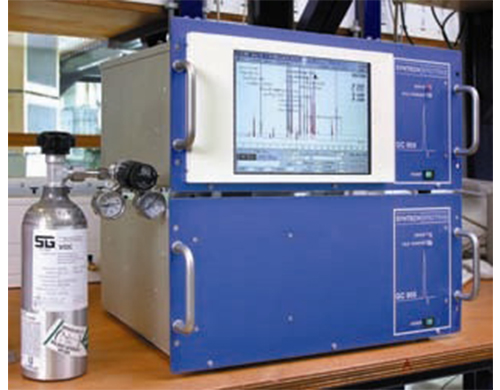Ozone precursor analyzer Synspec GC955 models 611 and 811
WHY MEASURE MEASURE OZONE PRECURSORS?
Ozone is among the most reactive substances in ambient air. In the stratosphere it has a protecting function as it will filter the strongest sun radiation. In the troposphere, the lowest layer of the air, it can be harmful for humans, agriculture and in nature.
Ozone is formed naturally, but also by a reaction of nitrogen oxides and hydrocarbons in certain atmospheric conditions. The reaction is faster under strong sun radiation, high temperature and high humidity. The products of these reactions are photochemical smog, containing not only ozone, but also very toxic hydrocarbons and fine dust particles. Ozone is a clear indicator of this process.
Depending on the climate the formation will also occur with low concentrations of nitrogen oxides. The hydrocarbon concentration is then the limiting factor in the ozone formation. As different hydrocarbons have a different reactivity in the ozone formation it is useful to measure the individual concentrations.
Specifications:
The system 611 is a gas chromatograph with a built-in preconcentration system. Hydrocarbons are pre-concentrated on Tenax GR, desorbed thermally and separated on an DB1 equivalent column, to reach optimal separation from interfering hydrocarbons. Analysis is done by a photo ionization detector. This ensures high sensitivity and good identification.
The system 811 is a gas chromatograph with a built-in cooled preconcentration system. Hydrocarbons are preconcentrated on Carbosieves SIII at 5 o C, desorbed thermally and separated on a combination of two columns, a capillary film column and a capillary PLOT column. In this way the low boiling hydrocarbons can be separated. Analysis is done by a photo ionization detector and a flame ionization detector. This ensures high sensitivity and good identification.
|
|
611 OZONE PRECURSORS FRACTION C6-C10 |
811 OZONE PRECURSORS FRACTION C2-C5 |
|
General |
SERIES 600, cycle time 30 min, temp program 20 - 90 oC |
SERIES 800, cycle time 30 Min, temp program 50 - 100 oC |
|
Detector |
PID detector. Lowest detection level for benzene 0.4 µg/m3 (0.15 vppb). Range: up to 300 ppb.. |
PID and FID detector. Lowest detection level for butene 0.4 µg/m3 . Range: up to 300 ppb. |
|
Reproducibility |
typical <3% пatри 1ppb (benzene, with capillary column) |
typical <3% at 1ppb (1,3-butadiene, with capillary column) |
|
Consumption of gas |
Nitrogen: quality 5.0, 4 bar, 25 ml/min |
Instrument air: dry and clean, 3 bar, 2 x 250 ml/min Nitrogen: quality 5.0, 4 bar, 25 ml/min Hydrogen: quality 5.0, 3 bar, 20 ml/min |
|
Dimensions |
19” rack, 5 standard Height Units, depth 39 cm net |
19” rack, 5 standard Height Units, depth 39 cm net |
|
Power demand |
220 V AC, 200 VA (110 V AC available) |
220 V AC, 200 VA (110 V AC available) |
|
Included hardware |
Computer Pentium III class, hard disk ≥40Gb, 2.5“, display LCD 10.4 “ colour, various data connection options |
In an 611/811 combination, shares the computer of the 611. Can be provided with its own computer |
|
Included software |
WindowsXPe for controlling the device: direct monitoring by keyboard and mouse, or from a remote head PC (RS232 / Ethernet LAN / modem), it is possible to create protocols for data exchange; Set of programs for gas chromatography Synspec |
|
|
Extra equipment needed |
For the application 811 Permapure dryer, included in the system, needing 250 ml/min dry zero air For the application 611 no extra |
|
|
Instrument gases |
Nitrogen best provided from a bottle, optional from generator. Hydrogen and zero air: from a generator, optional from bottles. |
|
Our projects
Useful
Reviews
Head count
-
Как Вам наш сайт ENGLISH?
Нравиться 0 (%) Не нравиться 0 (%) Воздержусь 0 (%)


